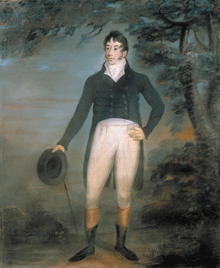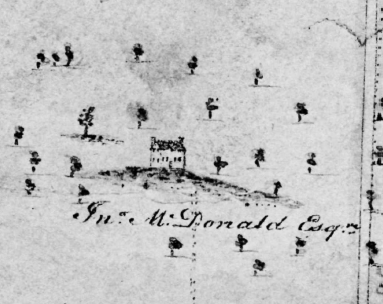You never know what you’ll find when doing historical research. I was recently browsing through an archival collection known as the Township Papers (Archives of Ontario, RG 1, Series C-IV). I came across an 1827 letter written by John McDonald of Garth, pictured below, an historical fellow who I know very well. In the letter he described his alleged land rights, and also cheese!

McDonald built the stone dwelling that is now known as Inverarden House, located on the outskirts of the City of Cornwall, Ontario. It was his retirement home, where he reposed after a boisterous fur-trading career in the famous North West Company. An early depiction of the home, found on a survey plan, is pictured below. He was active in the Cornwall community following his long retirement, and was one of the last surviving partners of the old company.

The letter he wrote was addressed to John Beverley Robinson, who once studied in Cornwall. He had attended Rev. John Strachan’s famous school in that community, and even boarded with Strachan during that time. In 1827 Robinson was the Attorney General of the Province of Canada – a colonial political jurisdiction that eventually became the provinces of Ontario and Quebec many decades later.
McDonald had evidently promised to send Robinson some samples of cheese, whose maker he referred to simply as “the woman.” He explained:
“I have not been able to send you the cheese, the fact is the woman had only three small curds, consequently small indifferent cheeses. She would not risque her reputation for cheese-making by sending any so far this season. Next year she expects to do better.”
The woman in question might have been his second wife, Amelia McGillis. They were married in 1823. It might also be possible that he referred to his first wife, Nancy Small. She was still living at the time of his marriage to Amelia, and she remained a neighbour of his in this period. Or he could simply be referring to a labourer on his large farm near Inverarden House, but this seems unlikely.
The main object of the letter was to lobby for a land grant from the colonial government, in particular for an island in the St. Lawrence. In typical McDonald fashion, he was assertive in his letter, stating that “I have never got one inch of soil from the Crown, though I have added by discovery many thousand miles to it.” He was referring to his activities during his time in the fur trade, when he established posts in the North-Western part of North America, which helped solidy the British-Canadian presence there.
Those geo-political aspects of the letter are fascinating, but I’m also interested to learn more about that cheese. What kind was it? Did “the woman” make a second attempt the following year? Was she more successful? Perhaps we’ll never know.